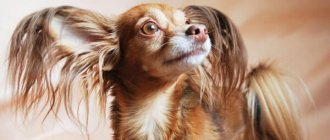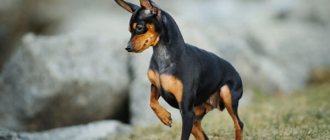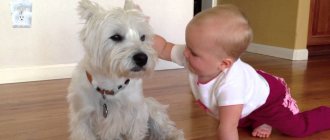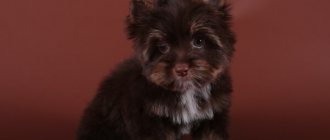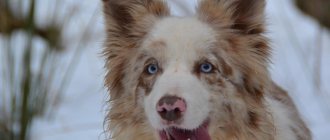Who wants a cute dog? Affectionate and devoted, beautiful and small. For anyone who dreams of one, we suggest paying attention to the toy terrier. The dog is a toy with a golden character. A stable psyche, ideal exterior and excellent disposition make this breed an excellent companion.
Good advertising for the breed, right? Bad advice for adults who love dogs. But they know little about breeds. Let's look at the standard of the toy terrier and its character traits.
Origin
Only the British could breed such a dog. Lovers of biting others invented a dog to match themselves.
Joke. At the time when the toy terrier became popular, there were good people living in Great Britain. And a dog was needed to exterminate rodents.
If you take a closer look at the standard of the toy terrier and its appearance, you will notice similarities with the Manchester “brother”. They are so similar that in the USA, for example, they are called the same. But it's not right. The Manchester Terrier became the ancestor of the Toy. However, according to the FCI, these are different breeds.
The situation was like this: the “Manchesters” gave birth to small puppies. Much less than parents. They became interested in noble ladies who wanted to have a toy dog. Soon the entire London nobility was babysitting dogs. They were carried in their arms in the literal sense of the word.
The dog turned out to be a character. The gentle fingers of the ladies were decorated with marks from the teeth of their pets. But that didn't stop women from loving their dogs. In addition, it turned out that the toy terrier is capable of killing rats. This little guy hated rodents.
From England, dogs spread throughout the world. Today, according to the Toy Terrier standard, there are two types. Short-haired and long-haired. The first is real English. The second is the result of Russian work. Breeders and dog handlers brought him out in the post-war period.
Factors influencing performance
Growth and development depend on proper nutrition. The diet should contain minerals and vitamins, especially calcium, and healthy fats.
Decide on the type of food - natural or food. Mixed nutrition is undesirable.
It is better to feed your puppy on a schedule:
- 1.5 – 3 months: 4 times a day;
- 2 – 4 months: 3 times a day;
- 4 – 6 months: 2 times a day.
Serving size for 3-4 meals a day is about 30 g. You cannot overfeed, otherwise excess weight will form.
Calcium and phosphorus are essential for strong bones and teeth . A calcium deficiency is indicated by the toy's ears. If they first rose and then hung, the puppy needs vitamins. Multivitamins should be introduced into the diet gradually, monitoring the pet’s health.
The puppy is taken for vaccination. The first vaccination is given at approximately 6 weeks .
This prepares the body for the next dose. The next vaccination is given at 2.5 months, it will protect the body from diseases - distemper, hepatitis, etc. If the puppy suffers some kind of disease, the consequences are irreversible.
For example, after the plague, chronic diseases of internal organs, blindness, and paralysis occur.
Every 3 months, puppies are given anthelmintic drugs for prevention . If the puppy is lethargic, eats poorly and does not grow, then this is a sign of helminth infection.
Breed standard
Descriptions of the Toy Terrier breed and the character of dogs attract the attention of many people.
- Height at the withers is up to 30 centimeters in males. Bitches barely reach 28 centimeters;
- The weight of dogs varies from 2.8 to 3 kilograms;
- The head is small and narrow. Seems disproportionate in comparison with the body;
- The transition from forehead to muzzle is pronounced;
- The eyes are large and round in shape. The only acceptable color is brown;
- Large nose, black;
- The lips are dry and fit tightly to the jaws;
- The jaws are long and narrow;
- The body is elongated;
- The chest is sunken and poorly expressed;
- The limbs are tall and muscular;
- The abdomen is strongly retracted;
- The tail is long, saber-shaped;
- Two types of wool. Short, shiny, without undercoat. Or long, wavy, close to the body;
- The colors allowed by the Toy Terrier breed standard can be black and tan, brown and tan.
Advantages and disadvantages
Pros:
- Keeping a toy terrier does not require much effort or significant financial investment.
- The dog does not take up much space in the apartment and is easily transported when moving.
- The animal is distinguished by devotion and high intelligence.
The negative qualities of the breed include:
- Difficult and quarrelsome character.
- Predisposition to limb injuries, as well as ear and eye diseases.
- Tendency to overeat.
The toy terrier must master the commands included in the OKD (general training course). Not every owner has enough patience and endurance to fully train a dog. The pet is poorly aware of its size and can be seriously injured or killed during a fight with a larger dog. Dogs do not tolerate cold winds and low temperatures well, so the owner should purchase special clothing for his pet.
Character
Baby - the dog has an interesting disposition. An ill-mannered dog of this breed is the storm of the world. He will build everyone: owners, guests, neighbors and yard cats. Only, if the owners love their baby, then the neighbors are not obliged to tolerate an inadequate dog nearby. Lack of upbringing can end disastrously for the dog.
The toy terrier standard (by character) does not provide for a ZKS exam. But he must have the basics of obedience. Unfortunately, most breed owners neglect this. By the way, a well-bred toy is a unique dog. He is obedient, devoted to his master to the point of oblivion, and is able to protect him. In case of danger, the baby dog will bravely rush into battle. It doesn’t matter to him that the enemy is several times larger. He will fight to the last, just to save his beloved owner.
He is patient with children, but will not allow active violation of his space. If the child is not affected by growling and light biting, then the pet will really use its teeth.
Ability to learn and train
Training a Toy Terrier is a complex process that requires considerable endurance. The dog does not tolerate being treated in an authoritarian style. She may refuse to obey commands and express her “indignation” with loud barking. The owner should actively use treats to reinforce commands included in the general training course. You cannot use violence against an animal.
Don't let your toy terrier sleep in your bed next to you. While sleeping, you may accidentally crush an animal. Jumping off the bed can be dangerous to your dog's limbs. If a toy terrier barks for no apparent reason, then you need to give the command “Ugh!” and maintain a strict tone. Don't let your toy terrier bite your legs. Undesirable behavior must be stopped with appropriate commands.
The animal can be trained to the tray. If the owner does not have time for a walk, the dog will relieve itself in a place specially designed for this. The Toy Terrier should not be treated as a “living toy”. If the owner begins to pamper the dog, the animal may become uncontrollable.
Where to buy a puppy?
A long-haired toy terrier and its “brother” that meet the breed standard can only be purchased in specialized nurseries. Breeders value their reputation, and the likelihood that a potential owner will be offered a defective puppy is minimal.
As for buying such an expensive breed secondhand, its consequences are difficult to predict. Unscrupulous people may sell a sick puppy. In addition, the lack of documents casts doubt on the pedigree of the animal. For a decent amount of money, the buyer acquires a phenotype. That is, a dog that looks like a representative of the breed in appearance. But in reality - a mongrel. Even if the blood of the best producers in the world flows in its veins, the lack of documents makes the dog a mongrel.
A Brief History of Russian Toys
The breed comes from the English Toys, who had a reputation as unrivaled rat catchers. Toy terrier dogs were brought to Russia during the reign of Peter I and by the middle of the 19th century they managed to gain popularity among the local bourgeoisie. Animals lived in imperial palaces and the chambers of rich ladies, accompanying them to balls and social events.
After the revolution, decorative toys began to be considered “bourgeois excess.” For a long time, salon dogs remained in the shadow of their larger counterparts of service and guard breeds. For almost half a century, they gradually died out and degenerated, interbreeding with local mongrels.
The modern history of the breed began in the USSR in the middle of the 20th century. In the 1950s, Soviet breeders decided to revive the population of decorative toys. True, at that time there were no purebred individuals left in the country. Therefore, enthusiastic breeders had to work with dogs without documents and animals exported from Germany as war trophies.
Due to the fact that at that time the country was pursuing an “Iron Curtain” policy, Soviet breeders did not have the opportunity to compare the resulting livestock with English Toys and for a long time did not realize that they had bred a new breed.
In 1957, an unusual male puppy with furry ears and feathering on his paws was born from a pair of Russian Toys, one of which was not purebred. The breeders really liked him and subsequently became the founder of a branch of long-haired toys. Despite its popularity, the Russian Terrier did not receive recognition from world associations for a long time and was registered in conditional status only in 2006.
Interesting! Translated from French, toy terrier means “dog for holes,” and the English prefix toy indicates its tiny size.
Features of care
Such a little girl, and how whimsical she is! It’s simply amazing when you see the list of requirements presented by elite nurseries to the future owners of their puppies.
We have reduced it as much as possible. The reader has only the most necessary information:
- Feed. Super-premium class for small breeds. Ideally, the food should be designed specifically for the needs of the Toy Terrier.
- Bed. Be sure to be warm, these dogs are prone to hypothermia.
- Warm clothes. From autumn to late spring, there is little walking with representatives of the breed. The dog requires warm clothes. If it blows, the treatment will be much more expensive than buying a costume for your pet.
- Veterinary services. It is better to remain silent about comprehensive annual vaccinations. Any owner knows this. But few people know that toy terriers need a quarterly examination by a veterinarian. Dogs are quite sickly, and some diseases can only be diagnosed by a specialist. Therefore, the owner should be prepared for the fact that he will have to pay a certain amount of money for tests and appointments with a doctor.
- Nail trimming. The manipulation is carried out once every three weeks. You can do it yourself. Or seek help from a veterinarian.
- Teeth cleaning. The Toy Terrier needs oral care. Representatives of the breed have thin tooth enamel, which must be cleaned with a special paste.
Adult pet weight
An adult dog weighs about 3 kg.
| Boys | Girls |
| 1.5-1.8 kg | 2-3 kg |
Sometimes there are mini toys weighing 0.9-1 kg. This weight is considered normal for a boy.
But if you are going to breed puppies, the Toya girl must weigh more than 1.8 kg for gestation and birth without complications.
More often 1-3 puppies are born . Their weight is 70-170 grams, which is a lot for such a small dog.
Expert opinion
Tolkachev Andrey Mikhailovich
veterinarian
The standard states that the weight should not exceed 3 kg. But such precision is needed for exhibitions. If your pet’s diet is balanced and there are regular walks, then a slight excess of 0.5 kg is not dangerous. Focus on appearance and the absence of symptoms of obesity: constipation, shortness of breath, sweating. Do not forget that there is a conditional division into super mini - 1.2 kg, mini - up to 1.5 kg and standard - 3 kg.
Choosing a baby
To choose your future pet, follow these recommendations:
Pay attention to the habits, character, and appearance of the kitten. The eyes, nose and ears should be clean. Any discharge indicates poor health.
The coat should be shiny and smooth. In the anal area there are no signs of loose stool.
Call them, the first one to respond will be the kindest. Loyalty is unlikely to be his trait; rather, an affectionate attitude will be manifested on his part towards everyone around him.
Consider deviations from developmental standards (weight, height, color). This is how much a kitten should weigh approximately:
| Age | Weight |
| 1 month | 200–650 gr. |
| 2 months | 320–1050 gr. |
| 3 months | 460–1550 gr. |
| 4 months | 600–900 gr. |
| 5 months | 700–2200 gr. |
| 6 months | 800–2500 gr. |
When purchasing a pet for exhibition purposes, you should immediately pay attention to all the subtleties required for toy terriers.
Check out the documentation and pedigree. And also specify how many times vaccination was carried out.
How long does it take to grow and how long will it stay with you?
When buying a baby that you dream of having with you whenever possible, you do not risk finding yourself in that famous situation from the joke in which the man found himself with the bear at the Bird Market. Your dog will not even grow to the height of your knee if it is a pedigree Russian toy, not bought secondhand in a subway passage.
Don’t make the main mistake of inexperienced owners: don’t buy if the seller can only confirm in words what is being sold. Do not buy a puppy that looks like a Russian Toy secondhand or from an advertisement - as it grows up, it can become like anyone, because no documents are attached to the puppy.
Deal with kennels and breeders of this breed, read reviews, look at adult representatives - choose a puppy of high quality breeding. Unprofessional breeding does not guarantee the purity of the breed and the absence of congenital defects!
It is believed that active growth in a Russian Toy stops by six months, after which the dog may grow and gain weight, but not by much. But the breed is still very young, and in fact the exact answer to the question: “When did your toy stop growing?” - only he himself can give. So far, each line of Russian toys has its own pace, and sometimes littermates grow and gain weight in different ways: some are “already completely ready” at 4 months, while others stop growing at 9 months .
Sometimes people who really like the breed are nevertheless afraid to get a Russian Toy: they think it won’t last long. The small size and fragility of the dog create a feeling of pain and fragility; it seems to people that this weightless creature was literally created in order to fly off to heaven at the most unexpected moment, leaving its inconsolable owners below.
It is a myth. The shortest lifespan is not at all for “kids”, but precisely for giant breed dogs - the Great Dane and St. Bernard are already old by the age of nine.
If your Russian Toy is healthy, leads an active lifestyle and is properly cared for, you will be able to hear his clear voice for at least 12-15 years! And in exceptional cases, much longer - among Russian Toys, as well as among dogs of small and medium breeds, there are stubborn long-livers .
Types by coat type
According to the type of coat, all toy terriers are divided into two large groups - smooth-haired and long-haired. As a rule, Russian Toys have long-haired representatives.
Smooth-haired
Today this is the most common and popular type and does not require additional care for the cover.
The fur of representatives of the species is short, but thick, dense, evenly distributed over the body. The cover is velvety with a noble tint.
Longhair
The length of the fur of these individuals reaches up to 5 cm. A distinctive feature is also the presence of fringe on the ears, which gives them a special charm. The muzzle area and the front parts of the paws are covered with short hair.
There is a variety of colors of this type:
- black;
- chocolate;
- ginger;
- platinum.
Contents in the apartment
If you listen to the opinions of many, many owners of a Russian Toy dog, you will certainly get the impression that half of these people are talking about one breed, and the other half about another . One cannot get enough of it, the other recalls with surprise the day and hour when they managed to contact this difficult breed. For the former, Russian Toys are friends and family favorites, for the latter, they are willful and capricious creatures that subjugate both their owners and their family, aggressive, noisy, causing a hundred outrages per minute.
The Russian toy will become the king of the house if you, the owner, allow it. But who is in charge then?
The pet will dictate the terms to you: what, when and how to feed it, where it should sleep, how to treat those who dare to live here besides it. Little tyrant - is this what you wanted?
Of course not! Why do you need this microscopic king in your house? If he acts up for one reason - because he can - it means that you allowed him to behave the way he likes .
Everything depends on you. The breed is highly trainable. Give your dog enough attention and there will be no problems with it. You can correct even learned bad behavior: just show your dog what he can do well and please you, and what he cannot do under any circumstances. It’s up to you to choose, a lot of funny tricks or just as many outrages - if the dog is bored without communication and training, he can only be outrageous . “Why train such a little one, it’s stupid!” No. It’s stupid to make a Russian Toy (like any dog) feel like an unnecessary piece of furniture. And if a dog of another breed can still tolerate this, the Russian toy will definitely create chaos .
Important: stop any manifestations of aggression: growling, attempts to bite. Sometimes owners think that Toy’s bites are not serious, he’s so small. Believe me, it is painful and unpleasant, especially if a child gets the bite. And be sure to find out if the child is the cause of the aggression. You never know, maybe your child has fun teasing a small dog, so much so that it chokes with anger.
If you don’t want to hear barking at every rustle, prohibit it.
The Russian Toy, due to its nervous structure, can give alarm signals almost constantly - to avoid this, teach the dog to bark only in certain cases, for example: someone rings the doorbell. Yes Yes! This decorative breed is an excellent guard dog .
Do you have children, cats and dogs, and do you think that the Russian Toy will not be able to get along with everyone? Believe me, with this baby you won't be too many .
If the environment is peaceful, he will fit in easily.
But if not very well, this little guy can begin to rebuild the local hierarchy in his own way! Remember that the Russian Toy breed was created partly on the basis of the Manchester Terrier breed, and these are fighters and brave rat catchers. A small smooth-haired dog, itself a little larger than “game” in size, was capable of not only standing up for itself in a fight, but also destroying not just one enemy, but many! The current representatives of the breed, of course, if they catch rats, they do it on their owners’ country property: they have retrained as athletes and actively participate in various training competitions, in particular in agility.
The Russian Toy breed is similar to its Manchester ancestors not only in appearance (smooth-haired, and even then not always, graceful, fragile in appearance), but also in its fighting spirit and perseverance in achieving goals.
These are excellent qualities, if they do not turn into aggression and grumpiness, when he reacts to absolutely everything that he doesn’t like with a nervous grumble, like a creature mortally offended by the whole world.
This will not happen if the dog has an owner who clearly explains to the dog that children and cats should not be bitten, and the most important person here is me, the owner, who will not allow anyone to offend the pet.
Stages of development
It is very important for any dog owner to know the correct rate and duration of growth of the pet, as well as how the proportions change in each individual time period.
Until what age is a dog considered a puppy? Here are the main stages of dog development:
- embryonic (while the embryo is in the womb);
- suckling (begins immediately after birth and lasts approximately 30-45 days);
- puppies (from one and a half months to six months);
- young animals (from six months to a year);
- young individuals (from one to two and a half years).
Attention! The most important foundations are laid during the prenatal period and during feeding.
At this time, the greatest acceleration of growth occurs. For example, the weight of an embryo on the fortieth day of a mother’s pregnancy can be about several grams, while a puppy emerges with a weight of 300g or more. up to 600g. In total, we have an increase in weight literally hundreds of times.
After birth, within a month, the cub increases its weight approximately five to six times.
At this age, the puppy already has all the typical signs of its breed, appearance, proportionality of the skull, ears, coat color, as well as bright constitutional features characteristic of the breed.
Males and females also differ in appearance. When the puppy reaches one month, the baby is weaned from mother's milk.
After three months, the growth rate decreases, although it remains at a fairly high level. And upon reaching the age of 6 months, the pet can no longer be considered a puppy, but transferred to the conditional category “young animals”.
Unofficial varieties of terriers
Finally, there are many species not recognized by the federation. Regarding terriers specifically, the following unofficial breeds are most often called:
- American Pit Bull Terrier;
- Patterdale Terrier;
- American Hairless Terrier;
- American Toy Fox Terrier;
- Biewer Yorkshire Terrier;
- Irish Staffordshire Terrier;
- Plummer Terrier;
- Old English Terrier;
- Rat Terrier;
- Teddy Roosevelt Terrier;
- Tenterfield Terrier;
- Toy Fox Terrier.
The Siberian and Dock Terriers are also sometimes mentioned, as well as other types of selection. But their distribution halo is insignificant, so we will focus on the top 50 representatives of the Terrier group.
Small terriers
Now let's see what types of small terriers there are.
Jack Russell Terrier
A dog that is similar in appearance to Parson, but has only 30 cm in height at the withers and 6 kg in weight. According to the nature of the coat, three types of individuals are distinguished: short-haired, long-haired and wire-haired. The breed is very fashionable, mostly ornamental, but with an energetic hunting ardor. On average, they ask for a puppy from 18 to 35 thousand.
Related article:
Small dog breeds - top 35 breeds with photos and brief descriptions. It may also be interesting to read a list of the smallest dog breeds with photographs and a brief description of their characteristics.
Japanese Terrier
It grows up to 33 cm and gains about 4 kg. The body is elegant, the muzzle is elongated, the ears are hanging, the coat is short. Japanese terriers are good-natured, even a little timid: they cannot stand noise and rudeness.
The price for puppies is negotiable, since this dog is considered an extremely rare type of terrier. Only 200 puppies were exported outside the Japanese islands, and in the country itself there are no more than 1.5 thousand individuals.
Australian Terrier
A small fluffy dog, up to 25 cm tall and weighing 6 kg. A cheerful playful companion, an active lover of chasing cats and rodents. He doesn’t like to be bored, so he can turn the house upside down if he doesn’t get enough activity. Such a pet will cost 15-30 thousand rubles.
Cairn Terrier
Scottish dog, a type of smooth-haired terrier. Height – 31 cm, weight – 7.5 kg. The wool is hard, all shades are possible except white. The dogs have a high watchdog skill, but more often active and sociable cairns become ordinary pets. Puppies are sold for 20,000-35,000.
Scottish Terrier
Also a Scotsman, but not an ordinary one, but the most famous terrier with a beard. The individual grows up to 28 cm, weighs 10 kg, has a squat build and short limbs. It is distinguished by high intelligence, hunting sense, vigilance towards strangers, obedience and friendliness towards its owners. The price of a puppy is from 25 to 40 thousand.
Norfolk Terrier
A type of small terrier of small height (25 cm) and weight (6 kg). The pet loves active games, gets along well with children, and is not at all aggressive. The price tag for puppies starts from 30,000 rubles.
Norwich Terrier
A compact dog with a fighting character. Outwardly similar to the Norfolk, only with rough hair and erect ears. Estimated at 30-50 thousand rubles.
Sealyham Terrier
Snow-white terrier dogs with silky long hair. They have a non-aggressive but stubborn character and are difficult to train. They ask about 25 thousand rubles for a puppy.
Czech Terrier
The second name is Bohemian Terrier. A rare species, similar in appearance to Sealyham, but more compact in size. The dogs are nimble, dexterous, and able to quickly and easily find prey. Height – 30 cm, weight – 9 kg. The character is soft and flexible. The price of a puppy starts from $500.
West Highland White Terrier
A short-footed dog, a type of terrier with a white, wire-haired coat. Height at the withers is 41 cm, weight – 9 kg. It has an excellent sense of smell and often functions as a search engine. As a domestic companion, he is energetic, friendly, proud and needs active walks. The price varies from 20 to 40 thousand rubles.
Dandie Dinmont Terrier
A type of small terrier with a rich “cap” of curls on the head. The individual grows up to 28 cm and weighs about 11 kg. Temperament is independent, persistent, but amenable to training. Dogs are friendly with people and love children. You can buy a puppy for 25,000-60,000 rubles.
Skye Terrier
Elegant bearded terriers come from Scotland. They are distinguished by their elongated hair and erect or hanging ears with feathering. They grow up to 20-25 cm, weigh from 11 to 18 kg. Puppy cost: from 15,000 to 30,000.
Nutrition
The diet of a toy terrier must be balanced and contain the necessary vitamins and microelements. Products that can be given to your Russian Toy:
- meat, 50-60 g per day - lamb, beef, beef by-products, chicken;
- lean fish, 1 yolk (no more than once a week);
- fresh vegetables: cucumbers, zucchini, carrots, cabbage, peppers, beets;
- porridge: buckwheat, rice;
- fermented milk products: fermented baked milk, kefir cottage cheese;
- fruits: apples, pears, bananas, peaches, apricots.
With natural nutrition, it is necessary to supplement your pet’s food with vitamins and microelements. You can make a table of the required additives in advance.
Pet stores offer a wide range of concentrated dry food and canned food for dogs. For a small pet, choose a product that is appropriate for its weight and age.
Good nutrition is the key to a toy terrier’s well-being.
